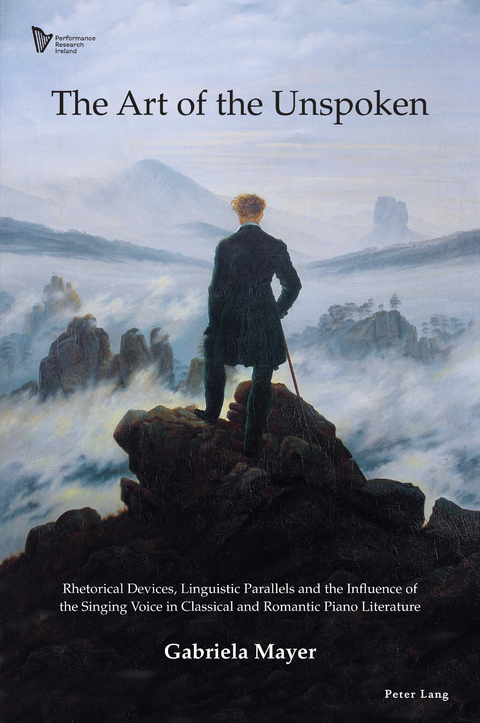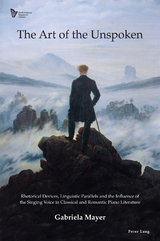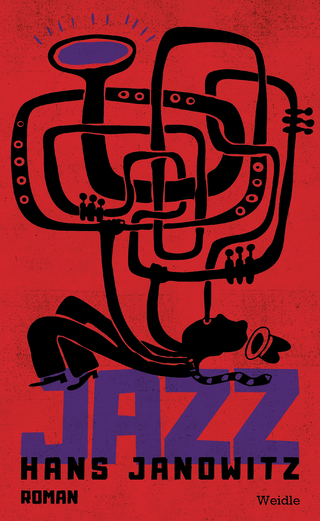The Art of the Unspoken
Peter Lang International Academic Publishers (Verlag)
978-1-80079-775-8 (ISBN)
How can musical meaning be conveyed without words? Starting with the landscape in which instrumental music developed traits parallel to language, this book explores a performance framework that connects qualities derived from rhetorical and dramatic elements and the model of the singing voice in Classical and Romantic solo piano music. These traditions were shared by composers, performers and pedagogues but have gradually fallen into obscurity. Rhetoric provides a guide for logical organization and persuasion, dramatic plot and character influence form and musical content, while singing offers a natural model for expression and inflection. Historical and aesthetic information along with literary and musical aspects are presented here to inform current performance practice.
Composers consciously employed rhetorical figures and expected performers to recognize and apply them in performance. Thinking of music in terms of plot and character cultivates habits of purposeful direction and clear definition of individual thematic material. Literary comparisons inspire the imagination and can be useful in addressing more complex aesthetic issues, such as organic quality in art, the concept of unity in diversity, memory, evolution and incompleteness. The desire to achieve vocal expressivity at the keyboard is a unifying factor that transcends the differences between varying types of pianos across time. These concepts have practical application to modern performance training, and a wider pianistic pedagogical context is explored in the final chapter, advocating for an integrated and meaningful approach to performance.
Dr Gabriela Mayer is a pianist, pedagogue, and researcher with a passion for connecting interdisciplinary insights. She is dedicated to sharing her performance training knowledge, which is deeply rooted in the classical tradition, but with a modern flair. Her focus is on an integrated approach, combining a nuanced understanding of the musical fabric within an aesthetic context with expression and sustainable technique. As a recipient of a Fulbright Graduate Fellowship to Germany, Dr Mayer studied piano performance at the Hochschule für Musik ‘Hanns Eisler’ in Berlin. She also completed a Doctorate in Musical Arts at the University of Maryland in the USA, graduating with the highest honours. Since moving to Ireland, she has engaged in teaching as well as performing, and currently holds the position of Head of Department of Keyboard Studies at the MTU Cork School of Music. She has given concerts and masterclasses at European music institutions and participates regularly in Erasmus projects, as well as conferences and seminars of the Association of European Conservatoires (AEC). Her interest in effective practice and performance preparation led to being part of the international collaborative project From Potential to Performance. Dr Mayer is also active as an international peer reviewer. Her students have won prizes and awards as well as securing professional careers.
Contents: Introduction – The Relationship between Language and Instrumental Music in the Eighteenth and the Nineteenth Centuries – Rhetoric and Its Echoes in Musical Composition and Performance – The Survival of Rhetorical Figures from J. S. Bach to Liszt – Dramatic and Poetic Influences – The Singing Voice as Natural Model – An Integrated Approach to Performance Training.
| Erscheinungsdatum | 04.05.2023 |
|---|---|
| Reihe/Serie | Performance Research: Ireland ; 1 |
| Mitarbeit |
Herausgeber (Serie): Una Hunt |
| Zusatzinfo | 8 Illustrations |
| Verlagsort | Oxford |
| Sprache | englisch |
| Maße | 152 x 229 mm |
| Gewicht | 319 g |
| Themenwelt | Kunst / Musik / Theater ► Musik ► Instrumentenkunde |
| Kunst / Musik / Theater ► Musik ► Musiktheorie / Musiklehre | |
| Schulbuch / Wörterbuch | |
| Geisteswissenschaften ► Geschichte | |
| ISBN-10 | 1-80079-775-3 / 1800797753 |
| ISBN-13 | 978-1-80079-775-8 / 9781800797758 |
| Zustand | Neuware |
| Informationen gemäß Produktsicherheitsverordnung (GPSR) | |
| Haben Sie eine Frage zum Produkt? |
aus dem Bereich




